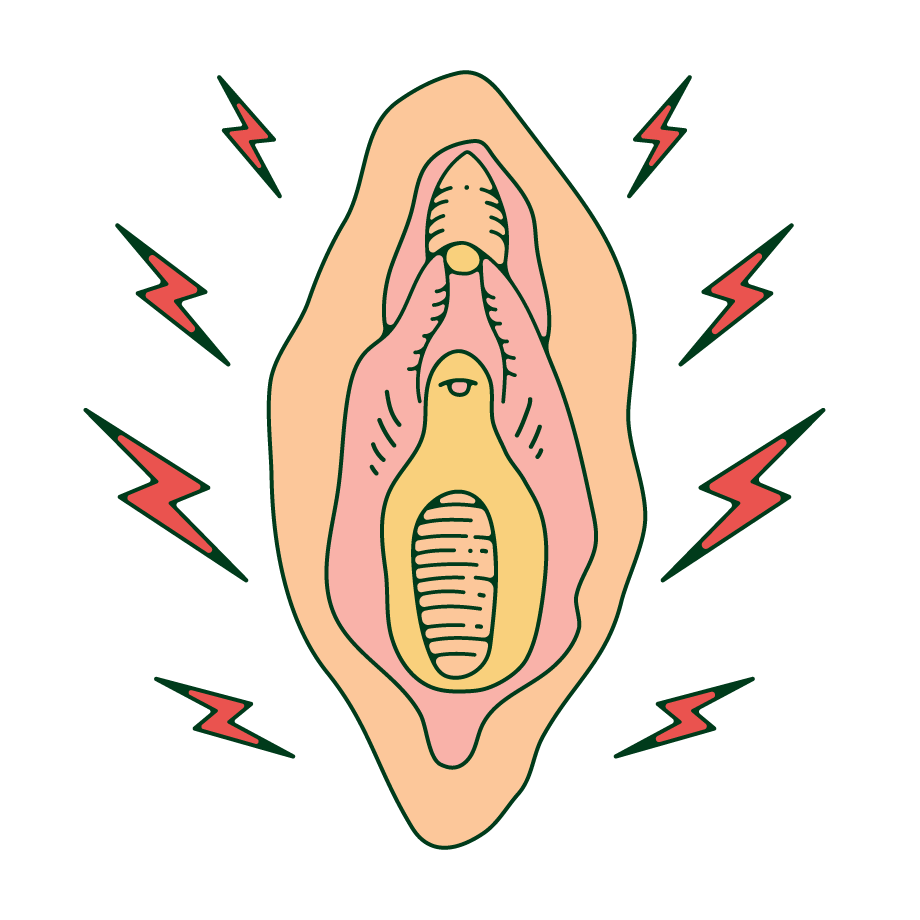Table of contents
1. What’s the difference between vestibulodynia and vulvodynia?
2. What are the causes and symptoms of vestibulodynia?
3. What are the causes and symptoms of vulvodynia?
4. What are some common misconceptions about vestibulodynia and vulvodynia?
5. How is each condition diagnosed?
6. How is each condition treated?
7. Why is it so important to get an accurate diagnosis of either vestibulodynia OR vulvodynia (or both, if both are present simultaneously)?
8. How can we care for the vulvovaginal pain more generally?
Medically reviewed by Sarah Montagu (NPs, SRH). Sarah is a highly-qualified sexual and reproductive health nurse with 15+ years of experience.
Illustrated by Sabrina Bezerra, Erin Rommel & Maria Papazova
Have you ever suffered from vulvovaginal pain?
How did it manifest? Did you find yourself wincing in pain during sex, biting your lip in agony as your hoped-for blissful, euphoric moment was replaced by a burning sensation that made your eyes water and your throat catch?
Perhaps you’ve gone to insert a tampon and found yourself gasping out loud – the tampon more akin to a lit cigarette forcing its way into your vaginal opening.
Or, maybe, your vulvovaginal pain hasn’t even been that bad. Nothing to write home about. But that sort of pain can be the worst; insidiously creeping its way into every area of your life, making its low-key throbbing and rawness apparent every time you pull on a pair of leggings or sit down at your desk. Low-level pain can slowly, steadily chip away at you (metaphorically speaking) – until you wondered why you ever decided against a doctor’s appointment.
The impact that vulvovaginal pain can have on women and AFAB folks should never be underestimated. Not only can it mean living with regular or recurrent pain, but it can – understandably – have an impact on social life, sex life, confidence and general wellbeing, too, which is why it’s all the more important to know what’s causing it.

Often, vulvovaginal pain is caused by one of two conditions: Vestibulodynia (also known as vulvar vestibulitis syndrome, or VVS) or vulvodynia. While vestibulodynia is a form of vulvodynia, the two conditions should not be confused – an accurate diagnosis of the root cause of vulvovaginal pain is paramount, because it means appropriate treatment that will actually address the condition causing said pain can then be prescribed.
So, we’re taking a deep dive into the differences between vestibulodynia and vulvodynia. The more you know, the more you can tell your doctor; and the more likely it is you’ll get a diagnosis that’ll help bani
What’s the difference between vestibulodynia and vulvodynia?
Essentially, vestibulodynia falls under the umbrella heading of vulvodynia; but it’s still a condition in its own right. The term ‘vestibulodynia’ is used to refer specifically to pain in the vestibule: “The entrance to the vagina,” says Dr. Ila Dayananda, OB-GYN and CMO of Oula Health. “It is often associated with pain or discomfort during sexual intercourse or other activities that put direct pressure on the vestibule.
“Vulvodynia, on the other hand, is a broader term that encompasses chronic pain or discomfort in the vulvar area, which can include the vestibule [meaning it’s possible to have both vulvodynia and vestibulodynia at the same time] but may also affect other parts of the vulva,” Dayananda continues. There’s no known cause of vulvodynia.
In other words: Vestibulodynia is localised; vulvodynia is generalised. “What differentiates them is the location,” agrees Natalia Obzejta, MD, Pelvic Pain and Endometriosis Specialist, adding that vestibulodynia can be accompanied by redness around the vestibule. On which note…
What are the causes and symptoms of vestibulodynia?
Dayananda lists potential causes of vestibulodynia as including the following:
- Inflammation
- Infection
- Trauma (which, we add, could include a micro-tear)
- Hormonal changes
- Autoimmune disorders
It’s worth adding, too, that vestibulodynia could be triggered (but not directly caused) by tight clothing or childbirth. “Its symptoms usually include pain or tenderness localised to the vestibule, particularly during activities such as sexual intercourse, tampon insertion, or even sitting for extended periods,” Dayananda expands.

What are the causes and symptoms of vulvodynia?
Vulvodynia, too, can have various causes – which Dayananda lists as:
And triggers can include having sex, using tampons or wearing tight clothing – or, as with vestibulodynia, even sitting. “Its symptoms may include chronic or intermittent pain, burning, stinging, or rawness in the vulvar area, which may be present even without direct contact or pressure,” Dayananda sums up.

What are some common misconceptions about vestibulodynia and vulvodynia?
Well, the main misconception, or myth, is that they’re one and the same, and that they can be treated as such.
“Another misconception is that these conditions are psychological or solely related to sexual activity when, in reality, they can have various underlying factors, including physical, hormonal, and neurological factors,” Dayananda explains.
“The most damaging misconception is that both conditions are purely psychological,” adds Obzejta. “The discomfort that these conditions cause is real and not ‘just in your head’. These conditions have multiple causes, with several subsets that need to be properly evaluated and treated appropriately.”
How is each condition diagnosed?
There can be some overlap between the two. “Diagnosis of [vestibulodynia] and vulvodynia typically involves a medical history check, physical [pelvic] examination and often specialised tests such as [vulval] swabs, or [a] biopsy to rule out other potential causes of symptoms,” says Dayananda.
But there is a distinction: While there’s no single test for vulvodynia, vestibulodynia can be diagnosed via a physical exam, in which a cotton swab is applied to certain points on the vestibule – thus helping a doctor work out how, and where, the pain is being triggered.

How is each condition treated?
Vestibulodynia may be treated via (for example) topical medications, pelvic floor physical therapy and/or pain management techniques – with the aim of reducing inflammation and/or pain sensitivity. In severe cases, there may be a surgical intervention, which, in this instance, would be a vestibulectomy.
Vulvodynia treatment options are similar, and will likely involve a multipronged approach that may include medication, physical therapy and lifestyle changes. Again, there’s a chance of being offered surgery to remove the painful part of the vulvar if other treatments have had no effect.
Why is it so important to get an accurate diagnosis of either vestibulodynia OR vulvodynia (or both, if both are present simultaneously)?
Where do we start?
- Appropriate treatment
“Accurate diagnosis is crucial for effectively managing and treating [vestibulodynia] and vulvodynia, mainly because either can have different root causes,” explains Dayananda. “Misdiagnosis, or mistaking one condition for another, can result in inappropriate treatment.”
Obzejta lists pelvic floor physical therapy as a prime example here: “It is important to have [a] specific diagnosis to know which muscles/nerves to work on,” she explains.
- Reducing the emotional impact
Chronic pain can take a serious toll on the emotions – and understandably so, given its ability to snake its tendrils into virtually every area of life. If you can’t even sit down without vulvovaginal pain, we wouldn’t blame you for feeling despondent, desperate and, yes, emotional about it.
- Ruling out other conditions
An accurate diagnosis may also help rule out other pain causes, like an STI or yeast infection – which can share symptoms with vestibulodynia and vulvodynia. If you have either of the former conditions, you need to know about it in order to get it treated – and an inaccurate vulvovaginal diagnosis won’t help with that.
How can we care for the vulvovaginal pain more generally?
“Some general tips for vulvovaginal pain are to wear loose-fitting clothing, use gentle and unscented hygienic products, practice relaxation and stress-mitigating techniques, apply cold packs for pain relief, and avoid potential irritants, including perfumes or dyes,” advises Dayananda.
“Seek care from [a] specialist [who] is comfortable diagnosing and treating these conditions,” suggests Obzejta – though it’s worth adding that, in the UK, you would have to be referred to a clinic by your GP; and waiting lists can be long, so it’s important to be prepared for that. But: “Support groups are [also] a good way for those suffering to find support,” adds Obzejta.
And remember: There are effective treatment options available. If you’re ever experiencing pain, discomfort or notice anything out of the ordinary, your first port of call should always be to make an appointment with a healthcare provider without delay, rather than self-diagnosing.
And, while you’re waiting for your appointment date, check out Hormonally’s guide on all things vulvar and vagina, aptly titled ‘What’s up down below?’ – because you can never know too much about your own body.







